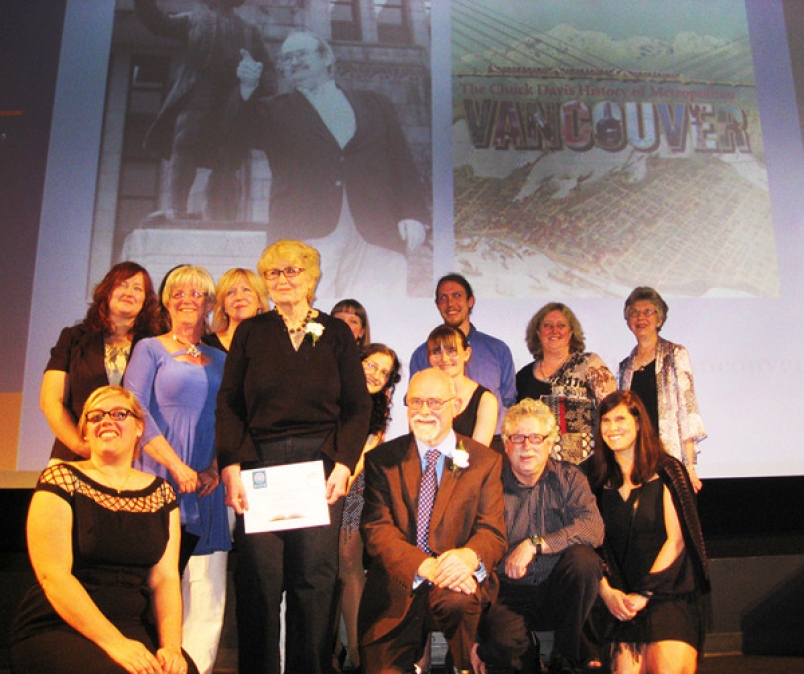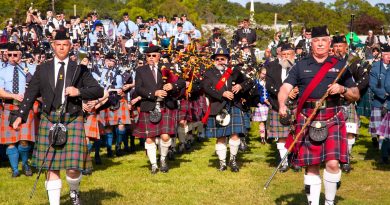Red’s Rock
by Red Robinson
In the Fifties the adult world looked upon us as a rebellious generation. As a part of that rebellion we had discovered the merits and talents of black singers. To buy a record by Lloyd Price, Ruth Brown, Wynonie Harris or Laverne Baker you had to go to a record store and ask for it by title and artist. The record clerk would bring it from the back of the store or from under the counter in a plain brown sleeve. They were called “race records” and were not featured on the racks along with all the nice lily-white recording artists of the day. This in itself was an attraction to the young—it was our feeling that if it was “bad” it just had to be “good”. The popular music slush of the era was not to our liking. Singers such as Frankie Laine, Vaughn Monroe, Patti Page, Eddie Fisher and the Four Aces were older cats and not singing to us. Teenage music as we know it hadn’t been invented at this point.
There was a radio show for Vancouver teens in 1953 called “Theme For Teens,” an hour-long show on CJOR hosted by Al Jordan. Jordan played the standard hits of the day and invited listeners down to the studio to take part in the show. He also accepted phone calls. I got enough nerve one day to call him and impersonate actor James Stewart. Stewart was in town at the time and I thought it would be great fun to phone Jordan’s radio show and spoof him. I must have done a convincing job because Jordan put me on the air and thought I really was James Stewart. I forget how the dialogue went but I do remember it was brief and I hung up quickly. It was a few weeks before I could work up nerve enough to call his program again. This time I called in the voice of actor Peter Lorre. This time it clicked with Jordan that someone was doing impressions and he stopped me midway through my call and asked who I was. I identified myself and he invited me down to the show.
Prior to this I had been collecting every magazine available on recording artists and deejays and decided to create an interesting “show business” name for myself. There were two reasons: one, to create a name people would remember and two, to hide my identity from my school pals if and when I ever made it behind a microphone. I chose “Red” Robinson because of my hair—and it’s significant that the initials were also the initials of the new music form. I visited the Al Jordan Show after school one day and stayed on to join in the fun each afternoon. I created a daily skit called “Rod Gat,” a parody on the then current Mike Hammer books. The mail this skit drew was unbelievable, and all the while Jordan was taking time to show me the ropes in radio. He eventually allowed me to take over the controls and engineer his program for him.
As “Theme for Teens” grew I became more and more involved and less and less interested in school work. I had decided radio was going to be my full time career. In the Fall of 1954 Al Jordan left the show and program manager Vic Waters, a great deejay in his own right, asked me if I would like to try to maintain it. I jumped at the chance. Without question the first day on the air by myself was the most hectic and nervous time of my life. I knew this was it, this was going to mean a quick start toward my goal as a career deejay or I was going to blow it entirely. I hit the air and kept on moving records through a full hour, on nervous energy alone. At the end of the hour the control room door flew open and Waters said the show was mine. He said the telephone reaction was great and he could live with what he had heard. What he had heard was a very immature voice, but a young man whose enthusiasm overcame a lack of announcing ability. I was totally hooked. I skipped school to learn everything there was to learn about broadcasting.
While employed at CJOR I was also attending a University of British Columbia course on broadcasting. During the day it was high school but after school until midnight or one o’clock in the morning I was totally immersed in radio. Having the freedom of expression and the stewardship of my own program I started playing those Lloyd Price records. In 1954 I moved swiftly to offering the music my high school peers were searching the dial to hear. I read every article in Cash Box and Billboard. I learned that Alan Freed was holding theatre parties at the Paramount in New York. I wanted to do the same. Nothing was really happening in Canada but in the United States Rock and Roll was on fire. I was determined to bring this new fad to my audience. In September, 1954 while other stations were playing hits like Hey There by Rosemary Clooney I was playing Sh-Boom with the Crew Cuts and the Chords. Pop stations were featuring The High and The Mighty with Victor Young and his orchestra and Little Things Mean a Lot with Kitty Kallen. I was playing Shake, Rattle and Roll by Joe Turner and a forbidden record by Clyde McPhatter and The Drifters called Honey Love.
The message was obvious to the youth of British Columbia and northwest Washington. Here was a young, high-voiced rapid-patter deejay playing their kind of music. It all came together when a Decca recording landed on my desk in July of 1955 . . . it was Bill Haley‘s Rock Around The Clock, and it changed the music world forever. I had graduated from High School the month before and this record holds a lot of significance for me. It launched Rock but it also stabilized my career: from that moment on it was uphill. The skyrocket had taken fire and was soaring. The music world would never be the same again. Radio would never be the same again.
The radio station sent me out on a remote around this time and it was a rampage. The remote was at a record store and the line-ups filled the street. At one shoe store remote so many teenagers turned up they broke all the showcases with just the mass of their bodies. The shock of these events hit parents hard and it was apparent in newspapers’ Letters to the Editor. One columnist referred to me as “The Platter Prince of the Pimply Set”. A writer referred to me as “The Pied Piper of Sin”. All of this of course added to the popularity of my show and the music. Everyone hated it—except the teens—and the show grew. I wasn’t about to let my new found discovery die. I took the records to high schools, parades, I rented airplanes and flew throughout British Columbia and Washington taking the music with me. At first I appeared with records at “sock hops,” but these graduated to local Rock and Roll bands and then imported name stars from the U.S. I would appear anywhere a young crowd was gathered, theatres, ball parks, even to the beach for outdoor sessions.
Radio was now more than ever available in automobiles and then along came the transistor. Now you could take radio with you wherever you went. This mobility allowed radio to grow and grow. It had not died as many had suggested it would with the coming of television. Records and radio were the entertainment art forms for youth along with movie theatres and drive-ins. All that was needed now was a music form. Rock Around The Clock became the teenage world’s national anthem.
The success of this record told the producers a new music form had been born. Some radio stations, either out of desperation to stay alive or because of an imaginative deejay, started playing this new brand of music called “Rock and Roll”. The difficulty was it took a deejay who was tuned in to the tastes of the times. I was “of” that generation. I understood the music, the audience and the excitement of a new discovery. And it was exciting. New artists, new music, new areas to enjoy. It was dance hops, live performances, new dances, new movies—and it was totally ours.
Every major act played this city during the fifties, either in night clubs like The Cave, or at one of the halls at the Pacific National Exhibition. The PNE was one reason Vancouver was on the list for all major acts. It was one of the biggest annual fairs in North America and was always on the circuit tour of the major booking agencies. And the Queen Elizabeth Theatre was a fine facility. Acts that worked up and down the Pacific coast always stopped off in Vancouver as part of their West Coast tour. I had met over the years every major act in the music world when many did not stop to play cities such as Seattle or Portland. My American friends couldn’t understand how these celebrities always seemed to find time in their schedules to perform in our city, but play here they did and still do.
When I started my deejay work on CJOR it was Western Canada’s first 5,000 watt radio station. In those years the radio dial wasn’t jammed up as it is today and you could hear CJOR over most of Washington and clear to Alaska. When I moved in 1957 to CKWX it was Western Canada’s first 50,000 watt radio station and at night the signal could be heard in Northern California.
The benchmark years for Rock N Roll were 1954 through 1957. I am proud to say the first regularly scheduled Rock N Roll radio show in Canada was “Theme For Teens” in 1953. Realizing the power of the radio show and its gigantic following, concert promoters started booking acts into this city starting with Bill Haley and the Comets in 1956. They were followed by the famous touring shows of Rock N Roll featuring all the main singers of the genre such as Chuck Berry, Little Richard, Fats Domino, Buddy Holly, Sam Cooke and so on. But the main event came in August of 1957 when Elvis Presley appeared at Empire Stadium. After this Vancouver was firmly established as a major destination for every Rock N Roll act that followed.
Cleveland lays claim as the first American city to feature Rock N Roll on the radio with the deejay who coined the phrase, Alan Freed. Vancouver was the first city in Canada to launch the brand new music form.
Vancouver is Canada’s pioneer Rock N Roll city and proud of it. The tradition began here.
(For more from Red, check out his web site at www.redrobinson.com)

![Red Robinson [Photo: redrobinson.com]](https://vancouverhistory.ca/wp-content/uploads/2021/01/red_72_0040-600x445.jpg)


![Fairview Baptist Church in Vancouver [Image: FairView Baptish Church]](https://vancouverhistory.ca/wp-content/uploads/2021/01/10247407_669782893067748_6617630364129196857_n-390x205.jpg)